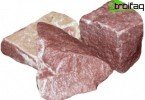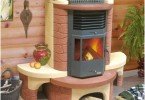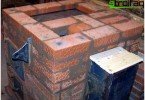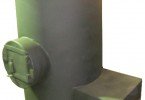Gas stoves for a bath
What is the main thing in the bath? “Of course it’s warm!” I would like the bath to warm up quickly, keep it warm well: to warm the bones it was possible, as it should, to relax both body and soul. Even in ancient times, people knew the healing properties of hot steam. The goal is clear, requires implementation. The heart of any bathhouse is a steam room, its functionality depends on the choice of a heating furnace. Depending on the type of fuel consumed, there are electric, classic wood, combined and gas bath stoves. Each species has its own disadvantages and advantages. Consider today, what is a gas stove for a bath.
Content
- Principles for the classification of gas units
- Stone and brick gas stoves
- Metal gas furnaces
- Power calculation rules
- Gas or wood burning?
- Choosing an important part – burners
There are many options for installing gas furnaces. It is not easy to understand an unprepared person in the variety of types and features of installation, in order to clarify the situation a bit, consider the types of gas stoves for a bath, their design features and technical characteristics. All gas stoves for baths can conditionally be divided into several groups.
Principles for the classification of gas units
- according to the material of manufacture (stone, brick, metal);
- by type of fuel used (gas or combined);
- by type of burner;
- according to the method of installing a tank for heating water.
Stone and brick gas stoves
Stone and brick gas stoves for baths do not have significant external differences from traditional wood stoves, in fact, these are wood stoves converted to gas. Furnishing a bath with a stone or brick gas stove is absolutely not at the expense of the beauty of the interior – the classic look of an old Russian bath is preserved. Why, then, depart from tradition, you ask? – For the sake of the undoubted advantages of gas stoves – they hold heat well, evenly warming the steam room, in addition, gas as a fuel is often more accessible than firewood.
The disadvantage of these furnaces is a very long warm-up. A stone, unlike a brick, has better thermal conductivity, because a stone furnace heats up faster than a brick. The installation of stone and brick stoves requires certain knowledge and skills, so for their laying it is better to use the services of an experienced stove-maker.
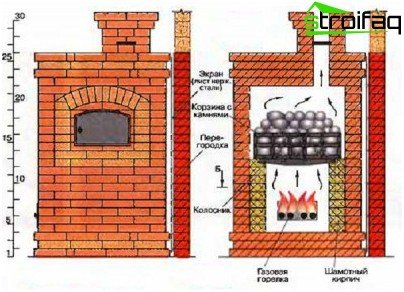
The scheme of the device of a brick gas furnace
The figure shows a general view of a gas brick stove, behind a furnace door (in the classic wood-burning stove model it is used to load firewood) there is a stove, its heating occurs due to radiation of energy from combustible fuel. The heater is located above the gas burner.
Metal gas furnaces
On sale today you can see a lot of metal gas stoves, they are much cheaper than brick or stone and installing metal gas stoves is easier. One of the indisputable advantages is compactness, which allows installing such furnaces in baths of various sizes, in addition, thanks to the thin metal body of the oven, the steam room is heated very quickly. And, importantly, there is an opportunity to choose a furnace with the necessary capacity for more efficient use of fuel, which means that there is an opportunity to save on energy resources.
When installing metal gas furnaces, thermal insulation is mandatory. Firstly, thermal insulation of the stove from the floor using a brick layer and a screen made of galvanized steel sheet, secondly, thermal insulation from wooden walls, thirdly, thermal insulation of the chimney when it passes through the ceiling and roof.
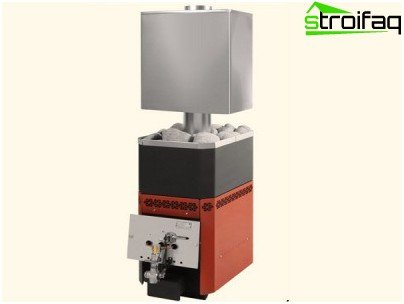
Metal gas furnace for a bath
A metal furnace can be installed in a few hours by a team of three people, and for outdoor decoration it will take one working day.
The answer to the question “which gas stove for a bath is better to put – stone, brick or, after all, metal?” depends on how often it is supposed to heat the bath. A brick, or even a stone stove, is heat-consuming, massive. It is more expedient to choose such a furnace if frequent use of the bath is supposed. If the bath will be used from time to time, periodically – it is better to choose a metal furnace. However, do not forget about the dimensions, for comparison, the weight of a brick furnace – from 750 kg, the minimum weight of a metal – 45 kg.
Power calculation rules
How to find out the required power? – By simple arithmetic calculations. It all depends on the area, and to be precise – on the volume of the room. According to the standards, 0.42 cubic meters of bath houses 252 calories. We multiply, substituting our values, and we obtain the necessary power. You can also calculate the efficiency of the unit, if you take into account how many times a month it is supposed to heat the bath.
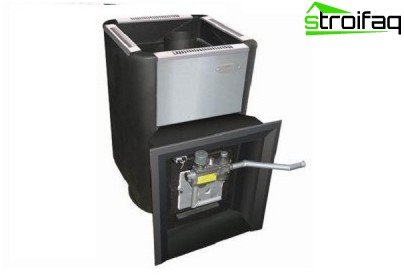
Combined stove for a bath
Gas or wood burning?
By the type of fuel used, a gas furnace for a bath can only be gas (uses natural or liquefied gas) or combined (except gas it can run on solid fuel). Combined stoves are universal, they make it possible to use firewood for their work, which positively affects the sauna atmosphere. Multifunctionality is an indisputable plus, but there is also a minus – large sizes, which greatly complicates the installation of combined furnaces. Regarding the issue of operation, pure gas stoves are much simpler and safer than combined ones..
Choosing an important part – burners
The most complex unit of a gas furnace is a burner; the safe operation of the furnace depends on the serviceability and stability of its functionality. Burners in gas furnaces come in two types: atmospheric and inflatable.
The arrangement of atmospheric gas burners is very simple, air enters the combustion chamber of the furnace under the influence of traction. Such burners do not create noise in operation and do not require electricity, they can work at low gas pressure, but when it fluctuates, adjustment of the flame force is required.
Inflatable gas burners are very effective, have forced air supply with an electric fan. An indisputable advantage of such burners compared to atmospheric ones is their efficiency and stability when the gas pressure drops in the main. There is a drawback – the dependence on power supply, in addition, the fan is noisy. An inflatable burner is not suitable for brick furnaces, because for the fan to work, it will require complete tightness of the furnace and chimney channels. It is difficult to comply with this condition, because the brickwork “breathes”, with excess pressure created by the fan, carbon monoxide can penetrate into the steam room through the pores in the brickwork. Atmospheric gas burner can be installed on any furnace.
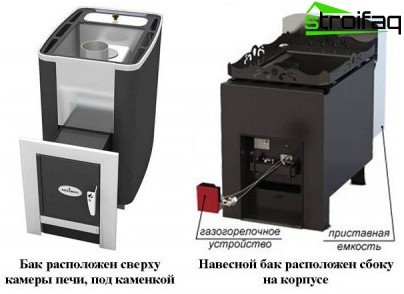
Methods of placing a tank for heating water
The gas oven in the bathhouse brings additional functionality: it serves not only to heat the steam room, but also to heat the water. To do this, there is a hot water tank in the stoves, the water in which is heated by the products of fuel combustion discharged through a chimney. According to the method of installing a tank for heating water, stoves can be placed above or below the stove, in both cases the chimney passes directly through the tank.
In terms of fuel costs, gas stoves are more economical than electric stoves, if you compare a gas stove with a classic wood stove, there is less trouble (you do not need to harvest firewood for the future, clean the chimney from soot and rake ash).
Installation of gas equipment on the site requires strict observance of all safety rules and standards. To install a gas furnace, gasification of the bath is naturally necessary. Gas is explosive fuel, the safety requirements are very high, therefore, the bathhouse must comply with current building codes.



